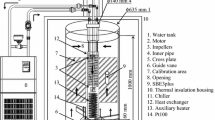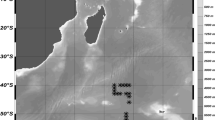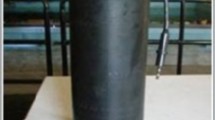Abstract
A new instrument for upper ocean survey, namely the UCTD (Underway Conductivity-Temperature-Depth), which combines some of the advantages of other underway instruments, is introduced in this paper. The Introduction section presents a description of the construction and function of the UCTD, and the experiments conducted in the South China Sea on board the R/V Dong Fang Hong 2 in July 2007 and August 2008. The UCTD system, with pressure and temperature sensors in the probe, is conveniently portable, cost-effective and environment-friendly. It is hopefully suitable for future cruises. An intercomparison based on regressing with the experiment temperature data from both SeaBird plus911 CTD and the UCTD showed that the standard deviation is 0.88°C and the correlation coefficient is 0.96, achieving the goals set for the current oceanography uses. In the hydrodynamic experiments, the descending velocities and depths were calculated for different ship speeds. A pulling test was designed with a tensiometer to measure the magnitude of the pull. The maximal tension of the line was found to be 66.2 kg, which is far lower than the bearing limit of the Hollow Spectra line. Finally, some improvement suggestions are put forward for future experiments and production.
Similar content being viewed by others
References
Alexander, S., and Darren, W., 2000. XBT/XCTD Standard Test Procedures for Reliability and Performance Tests of Expendable Probes at Sea. 3rd Session of JCOMM Ship-of-Opportunity Implementation Panel. La Jolla, California, USA, 8pp.
Elgin, R. H., 1994. An evaluation of XCTD performance with design improvements. OCEANS: Oceans Engineering for Today’s Technology and Tomorrow’s Preservation Proceedings, 1: 402–407. doi: 10.1109/OCEANS.1994.363868.
Emery, W. J., Lee, W., Zenk, W., and Meincke, J., 1986. A Low-Cost Digital XBT System and Its Application to the Real-Time Computation of Dynamic Height. J. Atmos. Oceanic Technol., 3: 75–83.
Ferrari, R. and Rudnick, D. L., 2000. Thermohaline variability in the upper ocean. J. Geophys. Res., 105: 16 857–16 883.
Flierl, G., and Robinson, A. R., 1977. XBT measurements of thermal gradient in the MODE eddy. J. Phys. Oceanogr., 7: 300–302.
George, B., and Daniel, J. M., 1984. A system for calibration of expendable conductivity, temperature, and depth (XCTD) probe. Oceans, 16: 210–213.
Gregory, J., 1995. Revised XCTD fall-rate equation coefficients from CTD data. J. Atmos. Oceanic Technol., 12: 1367–1373.
Herman, A. W., Beanlands, B., and Chin-Yee, M., 1998. The Moving Vessel Profiler (MVP): In-situ sampling of plankton and physical parameters at 12 kts and the integration of a new laser/optical plankton counter. Proc. Oceanol. Int., 102: 123–131.
Jerome, A. S., and Christopher, N. K. M., 1985. Estimation of quasi-geostrophic modal amplitudes from XBT/CTD survey data. J. Atmos. Oceanic Technol., 2: 491–507.
Keisuke, M., and Tomowo, W., 1998. Preliminary results of in-situ XCTD/CTD comparison test. J. Oceanogr., 54: 373–380.
Manning, M., Dalton, B., and Lancaster, R., 1987. XCTD sensors response characterization. Oceans, 19: 216–219.
Pankajakshan, T., Saran, A. K., Gopalakrishna, V. V., Vethamony, P., and Nilesh, A., 2002. XBT fall rate in waters of extreme temperature: a case study in the antarctic ocean. J. Atmos. Oceanic Technol., 19: 391–396.
Pollard, R., 1986. Frontal surveys with a towed profiling conductivity/temperature/ depth measurement package (SeaSoar). Nature, 323: 433–435.
Ren, W., Li, H., Li, Y. Q., and Du, M., 2008. Introduction of UCTD and Its Key Technologies. Ocean Technol., 27(1): 8–18 (in Chinese with English abstract).
Rudnick, D. L., and Klinke, J., 2007. The underway conductivity-temperature-depth instrument. J. Atmos. Oceanic Technol., 24(11): 1910–1923.
Rudnick, D. L., and Luyten, J. R., 1996. Intensive surveys of the Azores Front I. Tracers and dynamics. J. Geophys. Res., 101: 923–940.
Zachariah R. H., and William, J. T., 1992. The fall rate of the T-7 XBT. J. Atmos. Oceanic Technol., 9: 470–483.
Author information
Authors and Affiliations
Corresponding author
Rights and permissions
About this article
Cite this article
Song, X., Li, H., Lin, X. et al. Sea experiments of the Underway Conductivity-Temperature-Depth prototype made in China. J. Ocean Univ. China 8, 409–415 (2009). https://doi.org/10.1007/s11802-009-0409-x
Received:
Revised:
Accepted:
Published:
Issue Date:
DOI: https://doi.org/10.1007/s11802-009-0409-x




